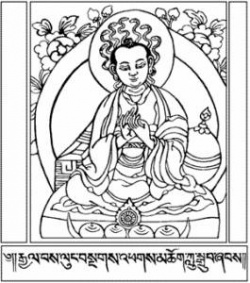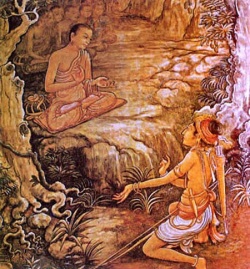The Twilight Language: Explorations in Buddhist Meditation and Symbolism, by Roderick S. Bucknell and Martin Stuart-Fox
3. The Twilight Language: Explorations in Buddhist Meditation and Symbolism, by Roderick S. Bucknell and Martin Stuart-Fox
out presupposing that SPB is always preferable to later commentaries or schools. As Griffiths himself shows, the store-consciousness idea itself is not immune from philosophical criticism (93). Overall this is an excellent work. Although there is considerably more to Buddhist meditation and its philosophical psychology than "cessation," this book is one of the most careful studies of a narrowly defined area of Buddhism ever to come to light. Griffiths is a philosopher's philosopher and a Buddhologist's Buddhologist. It is difficult to be even one of these; Griffiths is truly both. The main text is well-written, the production standard is high, and the backmatter (translations of key passages from Abhidharmakosabhasya and Abhidharmasamuccayabhasya in appendices, notes, bibliography, and index) quite useful. Without hesitation this volume can therefore be rightly recommended as a significant contribution to both philosophy and Buddhology. Frank J. Hoffman
The Twilight Language: Explorations in Buddhist Meditation and Symbolism, by Roderick S. Bucknell and Martin Stuart-Fox. London: Curzon Press, New York: St. Martin's Press, 1986. xiii + 233 pages.
In spite of Buddhism's rejection of an enduring essence anywhere in the phenomenal world, Buddhists and Buddhist scholars alike seem forever to have been intent on finding in Buddhism itself just such a core—a svalaksana, perhaps, on the basis of which to unify the vast disparity of traditions that go under the name "Buddhist." One of the more intriguing of recent attempts to find such a svalaksana—at least in terms of Buddhist meditation—is The Twilight Language, in which Roderick Bucknell and Martin Stuart-Fox employ a methodology "bringing together. . .phenomenological description of meditation, and the analysis of textual-historical data" (p. 197) in order to demonstrate that "the most advanced [[[Buddhist]]) meditation practices [were] not recorded in the Tipitaka, but [were] transmitted through a secretive, elite tradition," that "that tradition may have continued unbroken during the millenium between Gotama's death and the composing of the tantras" and that "the Vajrayana [was] a surfacing of the hitherto hidden elite transmission which Gotama had initiated" (pp. 33-34). Such a thesis, if proved, would alter greatly our understanding of the relationship between two types of Buddhist meditation that often are felt to be polar opposites: Theravadin satipatthana and tantric sadhana. Such a methodology, if successful, could change forever the way in which Buddhist studies are conducted.
Bucknell and Stuart-Fox's argument proceeds through four relatively distinct stages.
(1) In the first stage, the authors establish the relatively uncontroversial point that there is a fundamental difference between the two types of meditation favored by Buddhists, tranquility and insight, the one being reductive and non-discursive, the other inclusive and observational. They point out that the most common early formulation of the path, as eightfold, seems to emphasize tranquility at the expense of insight, but that the limitations of tranquility and the centrality of insight have been understood by Buddhists from the outset. Comparing the nikayas' apparent paucity of discussion on insight with the obvious importance of insight to Buddhists everywhere, the authors conclude that there must have existed an "elite meditative tradition" founded by Gotama to transmit the practices of insight meditation.
(2) Having analyzed the "early" textual-historical data and found clear accounts of insight meditation wanting, the authors are faced with having to provide an account of a phenomenon that they themselves admit is ill-defined. Their solution to the historical difficulties is to apply what they call a "phenomenological" methodology, whereby actual introspection—the practice of meditation—is employed to arrive at descriptions the texts do not yield. On the basis of their introspection, then, the authors conclude that insight meditation must occur in five distinct stages: (a) concentration, in which there is the attempt to still the mind on a particular object,
(b) thought-stream, in which, in the wake of concentration, we become aware of the fluidity and directionality of mind,
(c) retracing, in which the thought-stream is traced backward, (d) observation of linking, in which the relationships among the various elements in the thought-stream are understood and (e) awareness, in which one dispassionately, directly, observes events as they unfold in the present.
(3) Having discovered introspectively the actual nature of insight meditation, the authors are able to apply what they have discovered to understanding symbolically a number of important Buddhist categories and concepts that often are taken literally.
Thus, they explain the "three knowledges" acquired by the Buddha on the night of his enlightenment as his successive mastery of retracing (remembrance of previous lives), observation of linking (clairvoyant vision of the arising and passing away of beings) and awareness (knowledge of the destruction of the dsavas). His enlightenment or nirvdijta, thus, "was actually the attainment of [a] condition of permanent awareness" (p. 92), while the sarjisdra he transcended was simply the untamed stream of thought, the births and deaths of beings within it a symbolic way of referring to the arising and ceasing of images in the mind. Similarly, the various ariyapuggalas described in Theravada are to be classified not on the basis of the number of rebirths remaining to them, but on the basis of their progress in the fivefold path of insight; and the three marks of existents are related to understandings reached in each of the final three stages of insight practice.
(4) Finally, then, the authors analyze in some detail the fivefold symbolism employed in Buddhist tantric systems, especially in maqa'alas and the system of cakras in the subtle body. They conclude that this symbolism ultimately refers to the unfolding of the five stages of insight meditation described above. Thus, the different "dhyani Buddhas" of a tantric mawtala, as well as the various mudrds, vehicles, seed-syllables and elements associated with them, refer to different phases of insight meditation: "the mariaala does have symbolic meaning. . .it symbolizes the meditative path to enlightenment" (p. 148). By the same token, the different cakras in the subtle body refer not to "real 'psychic centres,' which can be opened if one applies the right meditative techniques" (p. 152), but—as we might now expect—to the stages of insight analyzed by the authors. Thus, the code behind the tantric "twilight language" {sarpdhd-bhdfd) that so long has perplexed scholars has been broken: it is insight that is intended by those knotty terms and symbols.
What are we to make of all this? There is much in Bucknell and Stuart-Fox's account that is interesting and provocative: their analysis of eightfold versus tenfold Theravada path-structures, their suggestions about the way in which symbolic systems are shaped to conform with pre-existing conceptual patterns and their explorations of the symbolic import of the elements of the marufala. Also, to their credit, they are modest about the evidence that can be adduced for their theory, which they consider "no more than a hypothesis which remains open to refutation by scholars working in the field of Buddhist studies" (p. 191). This said, it must be added that there seem to be considerable difficult
ties at every stage of their argument, and with the methodology, too. I cannot enumerate all the difficulties any more than I could spell out the argument itself in toto, but let me indicate some of the areas that appear most problematic, with regard first to Theravada, then to tantra, then to their methodology.
The first problem we encounter with the authors' analysis of Theravada is perhaps the most fundamental: their belief that insight meditation is not really taught in the Tipitaka, and that it must, therefore, have been transmitted by an "elite meditative tradition." Now there is little doubt that in the nikdyas insight meditation receives less detailed treatment than tranquility and/ or thejhdnas, and certainly its practice cannot fully be understood without the instructions of a teacher who must transmit knowledge beyond what is found in the texts. Nevertheless, this hardly justifies the claim that there is in the nikdyas a vast lacuna where insight ought to be, since insight meditation is discussed in considerable detail in the two recensions of the SatipaUhdna Sutta. Thus, there exists an overt, exoteric tradition of insight meditation to which the authors barely refer. The existence of this tradition would seem, ipso facto, to reduce the necessity or likelihood of an esoteric tradition such as the authors propose. The authors themselves admit that the existence of such a tradition is not given much weight by positive textual or historical evidence; and if the negative evidence they cite (the absence of descriptions of insight) is problematic, then evidence of any kind seems difficult to adduce. I am not denying that there may in fact have been an esoteric tradition in early Buddhism; what I am questioning is whether the authors have provided convincing evidence of such a tradition.
Further problems are raised by the authors' introspective discovery of the five stages of insight meditation. I have no quarrel with their fivefold process as a (possibly) accurate phenomenological description of what happens in general in meditation. What is problematic is the assertion that this is what Buddhist meditation really is and always has been. The existence of the exoteric tradition of insight meditation described in the SatipaUhdna suttas provides rather strong evidence that insight meditation traditionally has been regarded as fourfold, depending on whether its object is the body, sensations, mind or dhammas. The SatipaUhdna suttas give fairly detailed instructions on how each of these "foundations of mindfulness" is to be developed, and nowhere is anything like the authors' fivefold scheme suggested. Furthermore, the authors themselves admit that there is no textual corroboration for the stage of "retracing," and they provide no corroboration for what they call "observation of linking." Indeed, the only two of their five stages that do seem explicitly warranted by the texts are "concentration" and "awareness," which correspond to the two procedures that seem always to have been recognized by Buddhist meditators. Still a further problem is entailed by the authors' insistence that such central Buddhist concepts as rebirth, samsara and nirvana must be understood symbolically, as representing stages of insight meditation.
What is troubling about this is not the particular symbolic correspondences the authors draw, as the fact that they insist on drawing them. It is quite evident from their remarks in a number of places (especially p. 196) that they are uncomfortable with a literal reading of traditional Buddhist cosmology, and fear that it will be found irrelevant to the modern world if it is not reinterpreted symbolically. They regard the anlysis of mind in insight meditation as far more profound and compelling than a traditional cosmology, and so insist that that cosmology must merely be symbolic of the deeper process with which they are concerned. No doubt, traditional cosmology may be read symbolically, and often has been; this does not mean, however, that it never has been or should be meant literally, too—and some would argue that that literal reading provides the basic impetus and context for the practice of insight meditation itself. Thus, like so many modern interpreters of Buddhism, the authors go rather too far in insisting that Buddhists have not really believed things that Buddhists have, in fact, believed and, in most cases, continue to believe.
As noted above, Bucknell and Stuart-Fox have undertaken a detailed and fascinating exploration of tantric symbolism in that section of the book where they turn to the Vajrayana and its links to the "elite meditative tradition." They examine various lists of "dhyani Buddhas" and their correspondences with various elements, emblems, skandhas, mudrds, cakras, etc., which are, in turn, correlated with the stages of insight meditation. Unfortunately, their central contention, that the essentially fivefold symbolism of tantra represents the five stages of insight meditation, simply is not borne out. Though they have familiarized themselves with several of the symbolic schemes found in tantra, and availed themselves of a number of authoritative secondary sources in the area, the authors show little indication of having examined the ways in which marufalas or cakras traditionally are utilized, e.g., in the context of generation- or completion-stage sadhana practices. An appreciation of these sadhana contexts, in turn, should make it evident that, while a "meditation-stage" interpretation cannot be ruled out (one never can rule out alternative interpretations of tantric symbolism!), the symbolism does not seem centrally concerned to reflect meditative stages, so much as an array of divine forces. And, again, even if "stage-symbolism" is appropriate in some contexts, there is no evidence that the stages symbolized are those identified by the authors.
Another difficulty posed by the authors' treatment of tantra is that in analyzing the symbolism, they insist on a particular set of relations among the five stages of insight, the five dhyani Buddhas, the five mudrds and the five elements, such that any scheme that deviates from what they consider the norm is rejected or revised. Thus, the sequencing of the dhyani Buddhas Vairocana, Aksobhya, Ratnasambhava, Amitabha and Amoghasiddhi is declared to be "symbolically meaningless" (p. 150); and Amitabha is reassigned from the fire to the water element because of his association with the thought-stream and passivity (p. 185). It is not beyond imagining that there are inconsistencies and incoherencies in tantric symbolic schemes; on the other hand, to use a fivefold insight scheme that is itself a hypothetical historical construct as the a priori on the basis of which tantric schemes are to be understood and judged, seems precipitous.
A final, perhaps minor, difficulty with the authors' discussion of tantra is that they use the term "twilight language" quite imprecisely. If we grant for the sake of argument that this is an adequate translation for satfidhd-bhdsd, it nevertheless remains the case that the authors seem to take the term as synonymous with "tantric symbolism." There may be some sense in which this is true, but they fail to discuss the context in which twilight language most often is found: the dohas and carydgiti of the sahajiyds and mahasiddhas. We are a long way from understanding all that their twilit speech connoted, but the best guesses revolve around various completion-stage sadhana practices and the pursuit of that multivalent summum bonum, mahamudra; that twilight language symbolizes a set of practices like those discussed by the authors is not impossible, but it is less likely. Before closing, I want to comment very briefly on Buckneli and Stuart-Fox's methodology, which, it may be recalled, combines phenomenological accounts of introspection with textualhistorical analysis. Meditation hardly has been a standard tool of modern Buddhist scholarship. Some might regret this, as the authors do, and argue that meditation may hold the answers to
many historical and textual problems that are insoluble otherwise.
This may be, but if meditation is to be a tool of Buddhist studies, I fear that it must be used with greater care than by the present authors. The experiential sample from which they are drawing never is made entirely clear, and they are rather indiscriminate in their comparisons of these experiences with those of others, citing with approbation anyone, Buddhist or non-Buddhist, who appears to share their ideas, and ignoring or explaining away accounts that seem to differ. Thus, the fivefold scheme of insight meditation that they discover comes to exercise a kind of determinative tyranny over the book, shaping all textual readings, all historical analysis. Yet, as we have seen, the fivefold scheme may reflect an accurate account of the authors' sense of what meditation is and ought to be, but it does not tally so neatly with traditional Buddhist accounts of meditation—and that is what they are purporting to explain.
Indeed, if there is a central problem in the book, it may be that Bucknell and Stuart-Fox are not careful enough to separate explanation from interpretation or history from "theology." If they merely were saying, "this is our experience of meditation, and this is how we think Theravada and tantra ought to be interpreted by sensible modern people," they they would have made a valuable contribution to the ongoing process of Buddhist "theology"—indeed, I suspect that their views and modes of interpretation are shared by many. It seems to me that they are going farther, though, crossing the line into saying: "This is how it is and this is how it must have been, historically." When they cross that line, they are making assertions that they must corroborate by more than the silence of texts and their own intuition— and this they fail to do.
In spite of the problems in their arguments and methodology, we are in debt to Bucknell and Stuart-Fox for raising a host of issues that deserve further exploration. Can introspection serve as a methodological tool for Buddhist studies? If so, under what conditions? How will conflicting introspective claims be adjudicated? What is the process whereby symbolic schemes come to be the way they are? Do they spring full-grown from the visionary experience, or do they reflect the manipulation of pre-existent sets of terms that must be adapted to a new context? Are Theravada and tantric meditation as radically different as so often has been supposed, or are there not, at the very least, "family resemblances"—detectable in the textual tradition—that unite them? Are there, for instance, structural parallels between the practices of mahamudra and satipatthana (or, for that matter, Zen) that would allow us to detect among them a svalaksana of Buddhist meditation? Might this, then, not suggest that there is a clear historical continuity between the earliest and latest Buddhist meditative traditions? What positive evidence can be brought to bear on this process of transmission? My phrasing of these questions should make it clear that I think Bucknell and Stuart-Fox are on the right track with much of what they say, and I only hope that in future studies, either individual or joint, they will address the questions with sufficient rigor that the promises made—but not fully realized—by The Twilight Language can be fulfilled.
Roger Jackson





